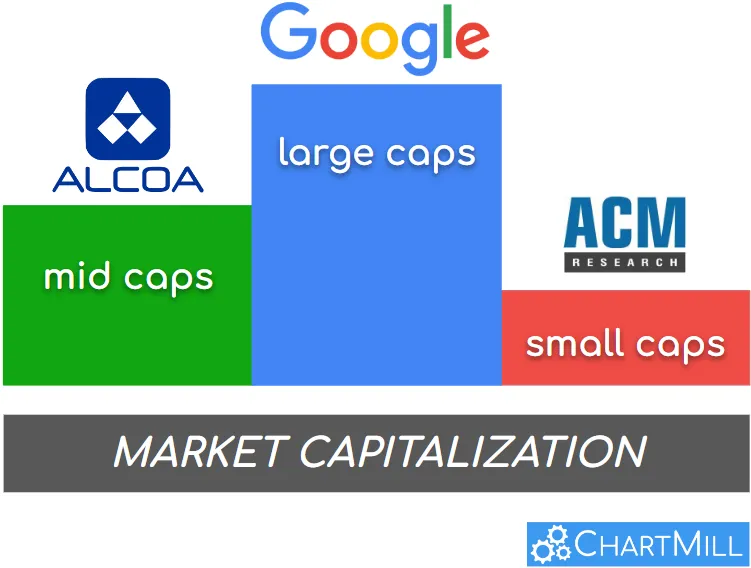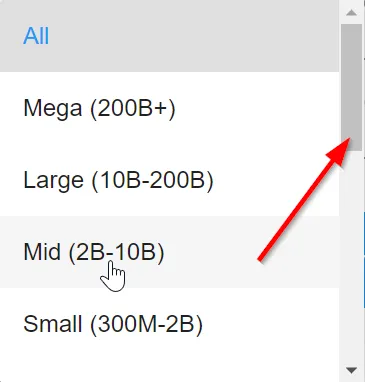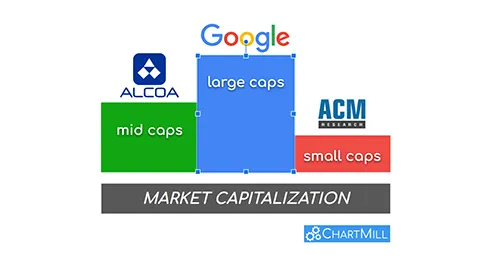Market Capitalization explained
By Kristoff De Turck - reviewed by Aldwin Keppens
Last update: Apr 19, 2024
Market capitalization - in addition to price and volume - is one of the basic characteristics on which you can select stocks for your portfolio.
In this article
- Definition of market capitalization and how is it calculated?
- Why is this figure important?
- The different categories
- 2 additional categories to be aware of
- Selecting stocks based on their market capitalization using the stock screener ChartMill
- FAQ

Definition of market capitalization and how is it calculated?
Market capitalization is a parameter to measure the overall company size. It is obtained by multiplying the number of shares outstanding by the current price of the stock. The result is then multiplied by the free float percentage on the stock market (the publicly traded shares). For many companies this free float amounts to 100% but sometimes part of the shares are tied up, for example with the founders of the company themselves.
As an example, suppose company X has 20 million outstanding shares that are currently quoted at $15. The sum is then 20 million * 15 or 300 million.
If the free float is 100% then this figure is also the market capitalization. If the free float is only 90%, one obtains a market capitalization of 270 million (300 million * 90)/100.
When a company is newly listed, the market capitalization is usually determined by the investment banks on the basis of the number of shares to be issued and the value they assign to the stock. Once the shares are then freely tradable, the market capitalization will fluctuate depending on the share price and any changes in the number of shares outstanding.
Why is this figure important?
Market capitalization is a first important parameter for those who want to invest in a company. After all, the share price on its own says nothing about the total value of a company. It is only when you consider the price together with the number of shares that you will get a first indication of the valuation. Market capitalization in itself, however, hardly plays a role in operational management. Rather, the figure is relevant as an acknowledgement and because it affects visibility.
After all, the higher the market capitalization, the more influence the company will have in its specific sector or industry and the more attention it will receive regarding related news.
For example, for the S&P500, companies are ranked based on their market capitalization (the larger, the higher the ranking). However, for the Dow Jones, the absolute share price outweighs the market capitalization.
The different categories
Depending on their market capitalization, companies are divided into different categories. The three basic categories are:
Large Caps
These are the large, established companies that everyone knows and for which a lot of public information is available. They have a market capitalization value of at least $10 billion. Because of their large market capitalization and resulting high turnover, they are less volatile, even during periods when markets are very active. However, that is not to say that they will not decline if general market conditions are negative! But as a rule, price movements will be a lot calmer.
Large caps, because of their mature market position, are often chosen for the dividend income. As further growth in such companies is rather limited, they are much better placed to pay out higher and stable dividends.
Mid Caps
These are the companies with a market capitalization between $2 and $10 billion. As the name suggests, these companies fall between the large and small caps, also in terms of their volatility. On the one hand, they still have plenty of growth potential, while their track record already offers a degree of security not found in small caps.
Because mid caps are a balance between risk (small caps) and safety (large caps), from a risk/reward point of view they are an interesting option for those who do not have enough capital to diversify their portfolio among small, mid and large caps.
Small Caps
The final basic category are the small caps. These are the companies with a market capitalization between $300 million and $2 billion. This category contains the companies with the greatest growth potential. Their smaller organizational structure makes them a lot more flexible than the mid or large caps.
Research also shows that small caps offer better returns compared to large cap companies but the downside is the higher risk and significantly higher volatility.
Moreover, with small caps the chance of takeovers or a merger is a lot bigger and on top of that this is more favourable for the shareholders within the small cap universe than within the large cap segment.
However, in this category one should pay extra attention to the liquidity of the stock. Due to their lower market value and lower visibility, there will also be less trading in these shares. So keep a close eye on the average volume and the spread between the buy and sell prices.
Investing solely in small caps is not the best choice due to the higher risk. If you do make this choice, at least try to diversify sufficiently between the various small cap sectors.
2 additional categories to be aware of
In addition to the three basic categories, there are two additional categories:
Mega Caps
These are the companies with a market capitalization of $200 billion or more. They are the very largest companies in the world and have exactly the same characteristics as the large caps, but with an even greater market capitalization. Some examples are Amazon and Google.
Compared to large caps, they have an even greater liquidity advantage. The immense buying and selling volumes make these shares interesting for really large investors such as hedge funds and institutional shareholders because it is possible to trade very large volumes in a very short space of time. Something that is much less obvious with mid or small caps, or even regular large caps.
Micro Caps
This term refers to stocks whose market capitalization is less than $300 million but higher than $50 million. These shares are usually traded over-the-counter (transactions outside the official stock exchange, mostly through a dealer network and less regulated than regular stock exchange trading). Yet there are also micro caps that are listed on the Nasdaq Capital Market or the American Stock Exchange.
Not surprisingly, this segment has the most speculative characteristics, which comes with much higher risk for those who invest in them. They offer very little safety because they are in the midst of the start-up phase. To finance their growth, they need a lot of cash while it is not at all certain that they will live up to their potential.
Investors are attracted to micro caps because of their highly speculative growth potential. However, keep in mind that success stories are the exception rather than the rule. Huge profits are possible but that possibility goes hand in hand with (much) bigger risk.
The main disadvantage with such micro caps is the sometimes very low liquidity and the fact that the possibility of price manipulation is considerably greater because of the very limited market capitalization. This is the reason why such companies are not considered by institutional investors.
However, the latter can be an advantage if, as an individual shareholder, you discover a micro cap at an early stage, which then succeeds in significantly increasing its turnover and profits, so that the company eventually does come into the sights of the major investors. The early shareholders then gain maximum benefit from the sudden increased interest.
Selecting stocks based on their market capitalization using the stock screener ChartMill
In ChartMill, you can easily select stocks based on their market capitalization. To do this, go to the stock screener page and choose the 'general' tab.
Open the drop down menu under the 'market cap' menu where you then have the choice of several filters.


FAQ
Can a company's market capitalization change?
Yes, the most obvious way is through the stock price, since it is part of the formula to calculate market capitalization. Since the stock price fluctuates every day and is determined by supply and demand, the market capitalization is subject to this.
But a fluctuation is also possible if the number of outstanding shares changes. This is the case, for example, when companies buy back shares, which reduces the number of shares outstanding. The reverse happens when new shares are put into circulation to raise fresh capital.
What happens to the market capitalization in a stock split?
A stock split means that the company puts new shares on the market but at the same time reduces the share price proportionally with the aim of ensuring that the market capitalization remains the same.




